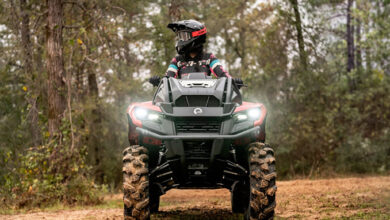Arctic Cat takes a close look at student project – June 5, 2006
Arctic Cat is considering producing a new snowplow design that features click-on technology, better ground clearance and one-time interaction between operator and plow when the winch is hooked up.
The technology was developed by five University of North Dakota engineering students as a senior-year project. The project was orchestrated by UND professor Ralph Johnson, who finds companies to pair with students. “Arctic Cat said they had a possible project involving a snowplow. It was rather revolutionary. (The new design) makes it extremely simple to hook up a snowplow.”
Arctic Cat officials said they were testing the model and may put it into production. Therefore, they were cagey about the details.
“We don’t want to take the spin away from the students at all,” said Arctic Cat engineer Tim Michalke, who worked closely with the students. “It was a great experience for both of us. It allowed us to see what kind of students the schools are capable of producing today. We gave them targets of equal or less than our existing plow, and they met them.”
Again, details were scarce, but one of the students, who asked to remain anonymous, joined Michalke in describing the newly designed plow as lighter, easier to ship, able to be applied to an ATV with less effort and greater speed while still maintaining the plow’s snow-moving capability.
Arctic Cat’s current design allows for the loss of three inches of clearance. The students design eliminates any loss of ground clearance, “no matter what tires you’ve got on your ATV,” the student said.
He said the plow weighs 75 pounds, which is what Arctic Cat’s current blade weighs. He said the new latching mechanisms are made of steel while the blade is made of ABS plastic, both of which are the same as current Arctic Cat design. The blade angle and curvature remained the same as well. “We figured if it works, why change it?” the student said.
They operated under strict guidelines from Arctic Cat. “We met all constraints they put on us,” the student said. For example, “we had to have a minimum lifting height of 13 inches, and ours was 18.5 inches.”
“We gave them the target of developing a plow to be no more or equal to the one we have today,” Michalke said. “Through their efforts, they were within two pounds of the existing plow, and that’s very impressive.” psb




